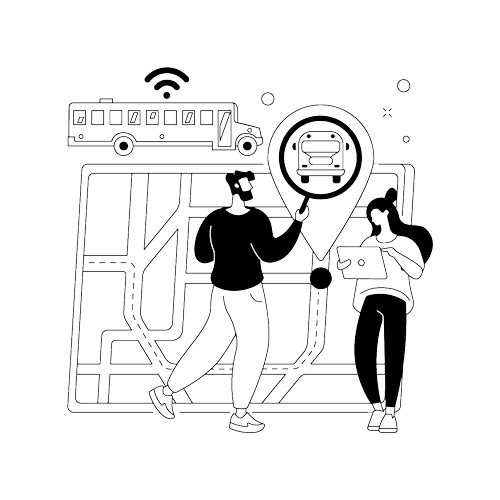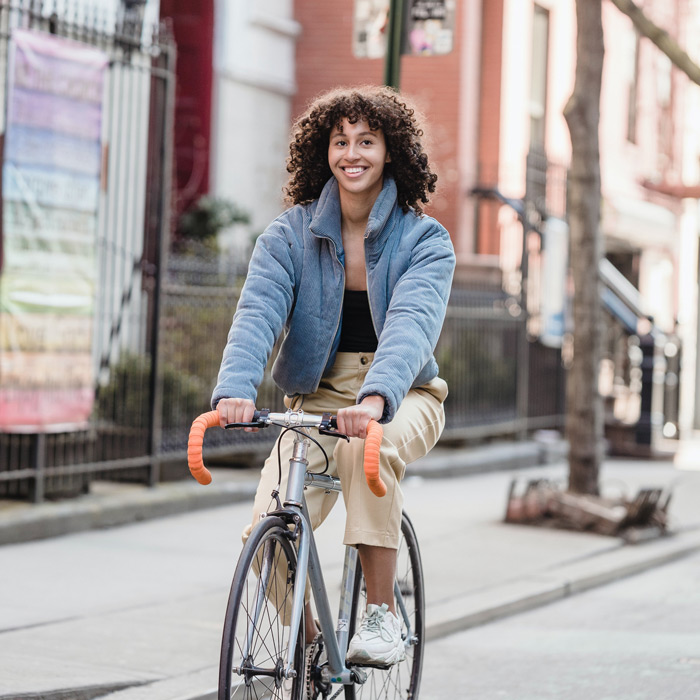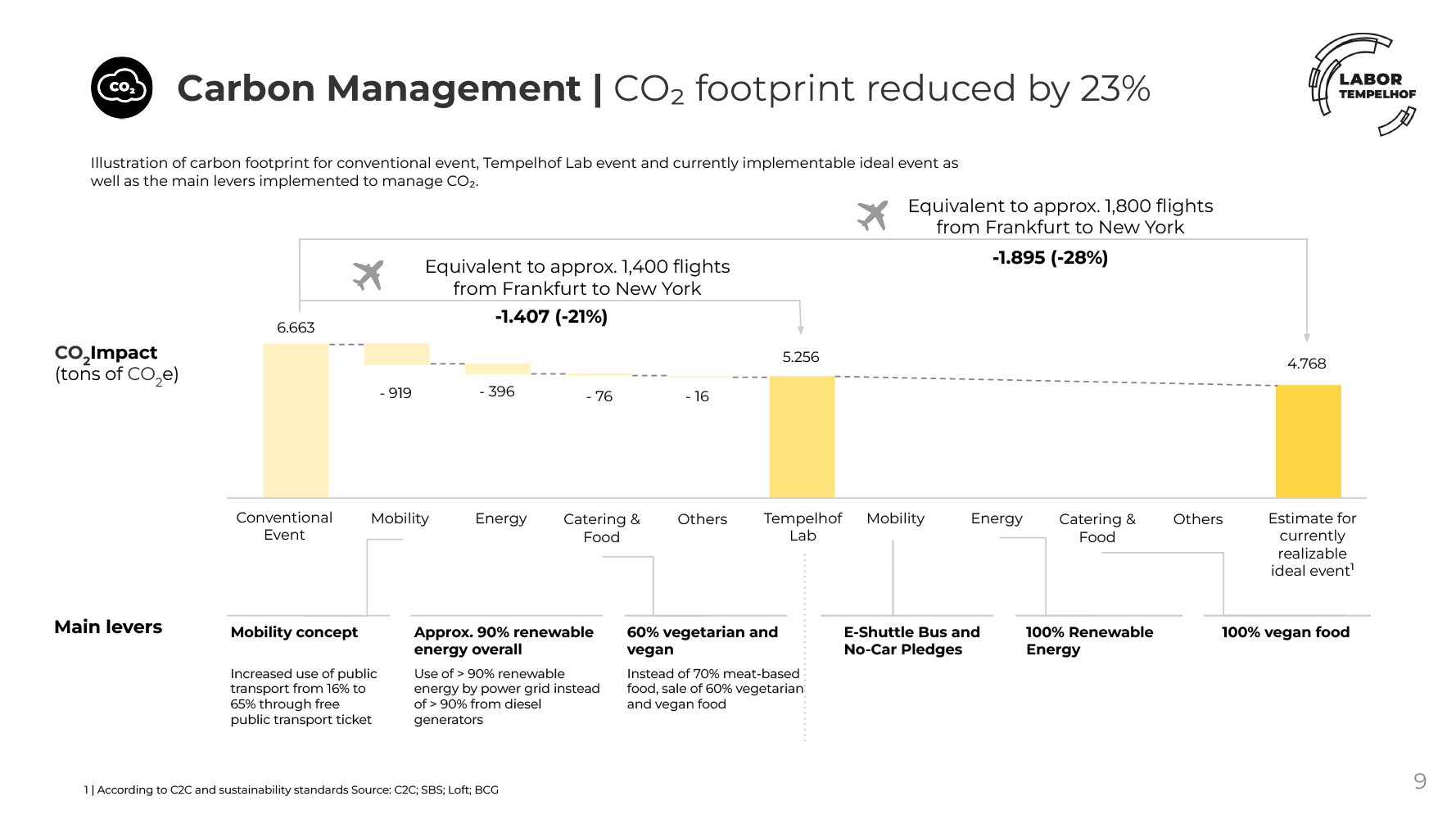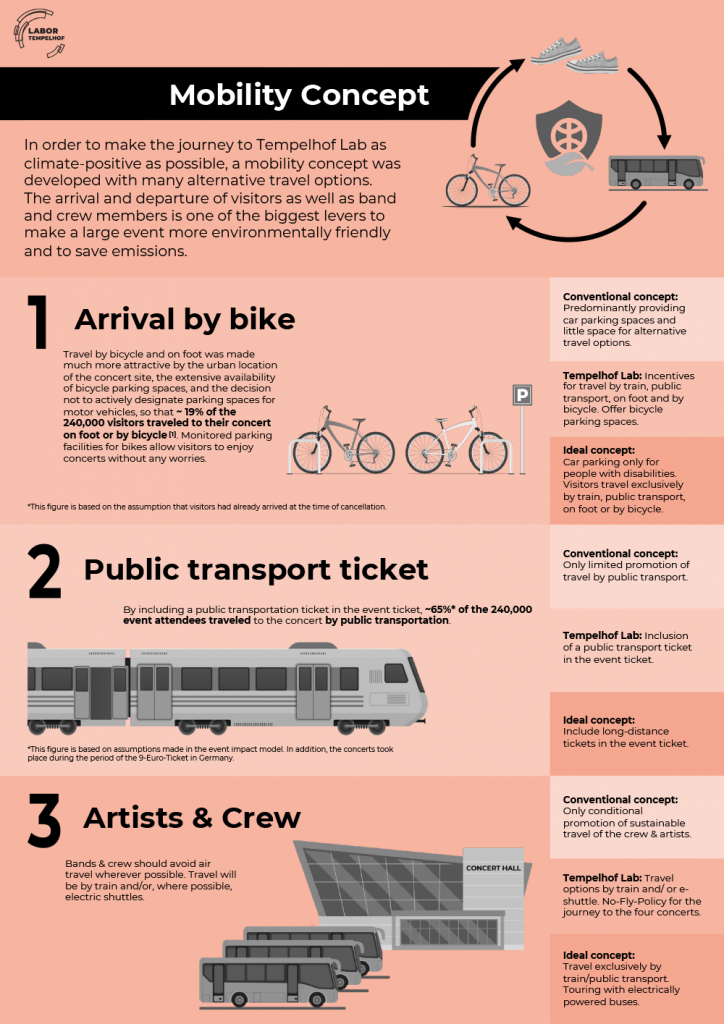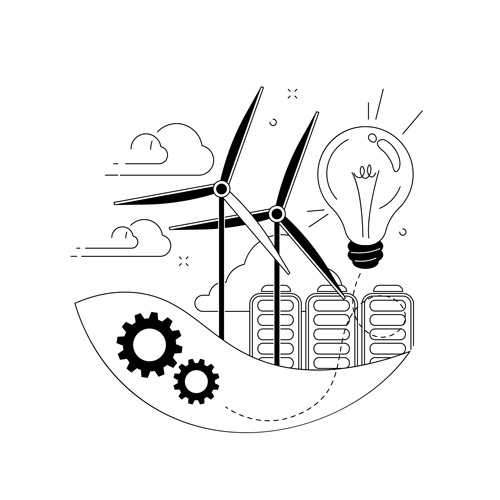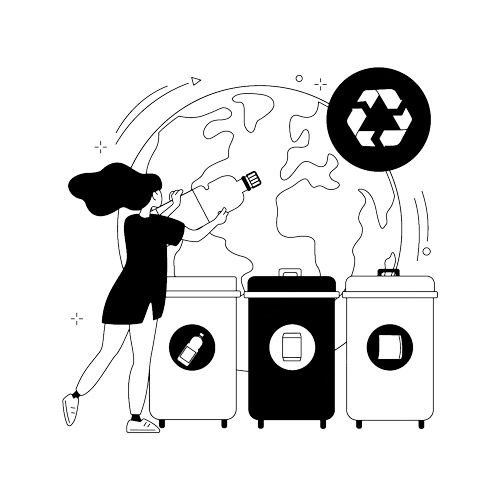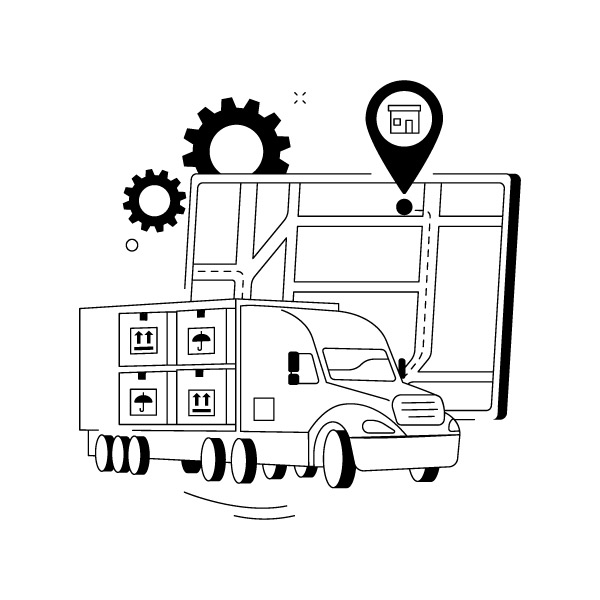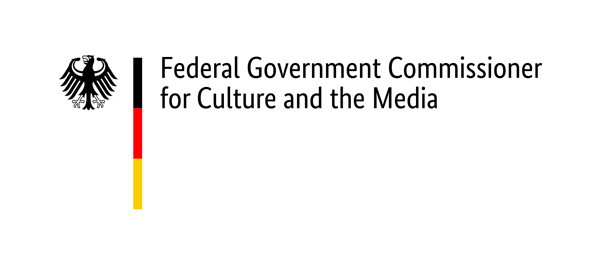1. Overview and problem statement
Did you know…?
Around 20% of CO₂ emissions in Germany in 2021 were attributable to mobility and logistics? 4
The proportion is even higher in the event industry. On average, 80% of CO₂ emissions for an open-air event are attributable to the attendees’ chosen means of transport to and from the venue: Biking is better than public transport, which is better than driving, which is better than flying. Higher vehicle occupancy lowers the emissions, which means carpooling and full-capacity busses should be encouraged for attendees who must travel by vehicle. 5
The challenge here is that the audience’s mobility can only be influenced to a limited extent by the organizers and bands and can therefore only be influenced indirectly. However, the situation is very different when it comes to event and tour logistics. Climate-friendly travel and logistics should be a priority for production and bands too. To reduce emissions and, ultimately, to set an example and remain credible.
Conclusion: The larger an event, the greater the leverage of mobility and logistics for CO₂ reduction.

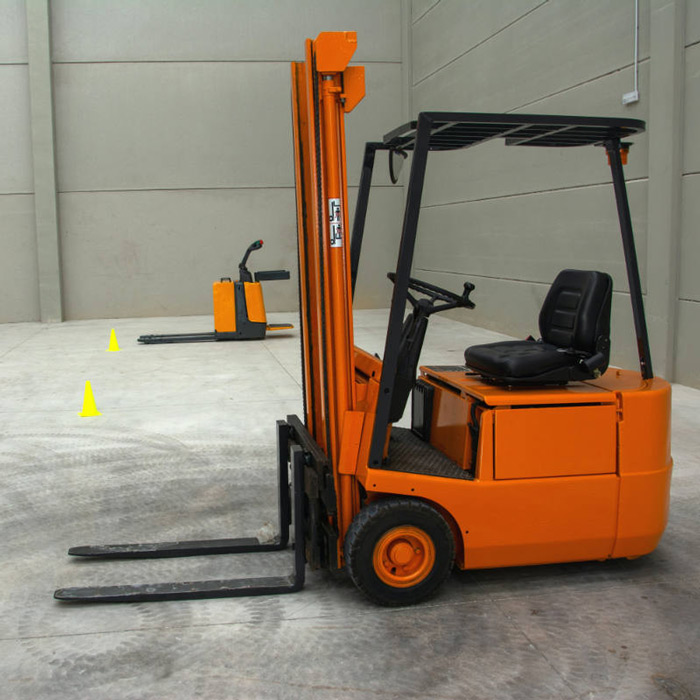

2. Our Benchmark for Tempelhof Lab
In order to implement the Tempelhof Lab concerts in the most climate-positive manner possible, we targeted these aspects:
MOBILITY
- Airplane travel (especially for short distances) is eliminated from the band- and crew budget.
- Transport crew by train (incentivize Deutsche Bahn card/ Deutschland ticket) and electric tour busses/ passenger cars/ shuttles.
- Efficient tour-routing with focus on urban centers and cities.
- Sharing is caring: The more people per vehicle – whether car or (tour) bus – the lower emissions per person. This is true for the bands as well as the public.
- Public transport ticket is included in the concert ticket price, requiring cooperation with the relevant transit authorities.
- Publicize climate-friendly transportation options ( by bike, public transport) to concertgoers (for example, via websites of the organizers/ bands or social media as well as available event apps).
- Offer free bike valet or otherwise free, secure bicycle parking.
LOGISTICS
- Tour logistics: Efficient routing and sustainably driven trucks.
- Promote awareness to artists and production team about material efficiency (e.g., what production setup is really required?).
- How can existing local infrastructure be used to economize transportation needs?
- Use e-vehicles (forklifts, wheel loaders, etc.) or cargo bikes onsite.
- When procuring goods, prioritize locally produced items in order to keep transport distances short.
3. What worked well, what can be improved?
Mobility
What worked well?
- Public transportation fees included in the concert ticket and communicated to concertgoers.
- Free, supervised bicycle parking directly at the concert site, publicized via the organizers’ website and the bands.
- Cooperation with Jelbi (mobility-app for the best routes and medium of transport inclusive of sharing options in Berlin) to offer transit and bike sharing options to concertgoers.
- Designated parking spaces for people with disabilities.
- Carbon offsets for unavoidable travel emissions by audience and production obtained from the climate protection organization atmosfair.
- Extremely limited number of backstage parking spaces, provided only in exceptional cases (e.g. for the materials required by stage production riggers).
- Zero air travel by the bands and crew.
- E-Shuttles for bands and tour crew.
- Train travel by bands and tour crew.
- Highest efficient class for nightliners: pollutant class Euro VI.
What can be improved?
- Collect data on audience travel plans instead of modeling based on anonymous ticket sales.
- Provide additional incentives for climate-friendly travel, e.g., through raffles, free drinks, discounts on food or merch, etc.
- Platform (or app) to enable car sharing or shared bus travel for concertgoers.
- Railcards for core touring crew.
Logistics
What worked well?
- Use of E- vehicles (for example shuttles, forklifts, golf carts, etc) onsite.
- Use of fLotte Berlin cargo bikes for onsite logistics.
- Highest efficiency class for the majority of trucks: Euro VI emissions class.
What can be improved?
- Unable to meet the objective of 100% e-vehicle use in logistics due to lack of availability.
- Unable to implement use of Hydrotreated Vegetable Oil (HVO) fuel in logistics because vehicle manufacturers are not yet liable for the use of HVO due to lack of experience.
- Euro VI emissions class was not used for all trucks; in the future, aim for 100% use and also consider use of e-vehicles 6 and nightliners for alternative transportation modes.

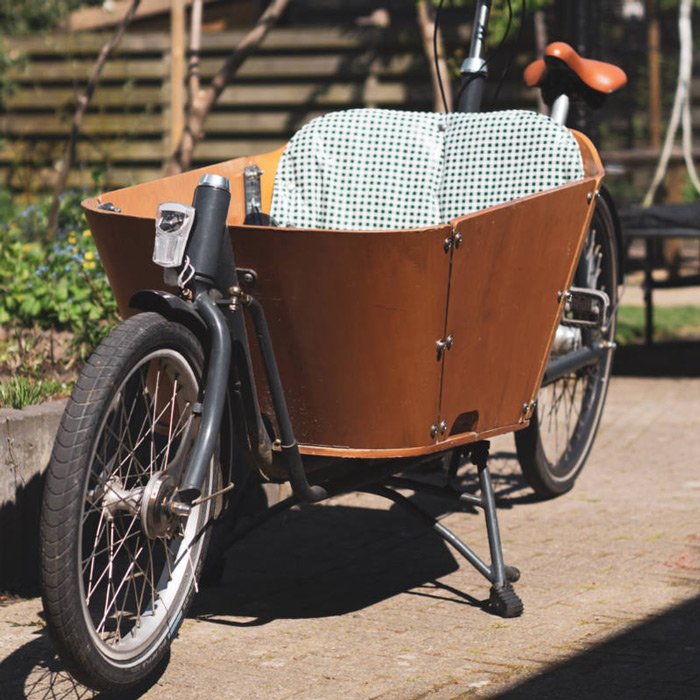

4. Findings and Recommendations
- Around 80% of the public traveled to the concerts by train, public transit, on foot or by bike. For comparable events, this rate is typically 40% 7. This measure prevented 900 tons of CO₂ emissions.
- Integrate public transit fare into the event ticket to incentivize its use
- When selecting the event location, ensure good public transit connections (S-train, U- train, railway, bus stops).
- Notify ticket buyers about the included public transit fare via ticket sellers and event organizers.
- Offering bike parking with 4,000 spots was worthwhile and completely full in good weather.
- Plan bike parking based on the season and the weather.
- Promote bike parking availability at an early stage, for example on websites of event organizers, bands, etc.
- Inaccurate data on audience’s travel modes
- Ask the audience about their travel choices through onsite surveys (e.g. at the entrance via QR code). Artists can spread climate-friendly travel awareness through announcements.
- The project team did not have the capacity to develop a platform (or app) for car sharing or shared bus travel for the audience.
- Use existing solutions on the market or outsource.
- Subsidized public transport tickets for employees were not offered because talks with the public transport provider failed. Nonetheless, the 9-euro monthly transit ticket in effect during the concert period in Germany helped ensure that crew and employees could travel cheaply by public transport.
- If there are no discount public transit offers, talk to the public transit authority at an early stage.
- If necessary, include the cost of employee transit fares in the budget.
- E-vehicles in production were sometimes not charged overnight and could not be used the following day.
- Offer onsite briefings and training of the relevant employees in production on e-vehicles and charging options.
- Plan the use and charging times of e-vehicles as precisely as possible.
- Due to shortages of production materials, short delivery routes could not always be used.
- When selecting suppliers, pay attention to short delivery routes, e.g. by selecting regional service providers.
- Especially in the area of heavy trucks, there are currently hardly any climate-neutral trucks (electric, fuel cell) on the market.
- Ensure early availability of trucks with the highest emission class (currently Euro VI).
- Request and demand certificates, information on fuels used (HVO, bio-diesel, hydrogen).
- Start talks with truck/bus manufacturers at an early stage to see if they will provide available electrically powered logistics vehicles as part of a joint pilot project.
- Despite all measures, climate-neutral mobility & logistics were ultimately only achieved by purchasing carbon offsets.
- When selecting an organization, look for certifications (e.g. CDM Gold) and projects with a long-term commitment of CO₂.
- Include CO₂ offsets in the event budget as an additional incentive to reduce emissions.
- No Fly Policy was effective and easy to implement.
- Communicate policy to crew and band/artists at an early stage and justify choice of train as means of transport.
5. Service Provider Contacts
- Berlin Public Transit System: Berliner Verkehrsbetriebe BVG
- Bike Parking: Bike Parking & Fahrradgarderobe
- Bikeshare connections: Jelbi
- Carbon Offsets: atmosfair 8
- Nightliner: Coach Service (für Euro VI-Busse) & Pepper Motion
- Trucks: Trucking Service (Euro VI-Lkw)
- E-Shuttles für Band/Crew: Spaceshuttle
- Freight bikes: fLotte Berlin (powered by ADFC)
- E-Forklifts: Zeppelin
- E-Golfcarts: Divaco
- E-Smartcars: Starcar
- Alternative fuels: ToolFuel



6. Further inspiration from the industry
Other bands, tour agencies and event organizers are also beginning to implement climate- and environmentally friendly practices. They are not only changing their own behaviors, but also trying to positively influence their audiences:
Massive Attack are planning to do their 2023 tour entirely by rail and are relying on trains for all tour logistics and travel. In addition, the band has developed a guide for 1.5 degree compliant touring together with the Tyndall Centre for Climate Research, which offers recommendations like “plug and play,” i.e. instead of renting and transporting the bulk of equipment for the tour, relying more on the conditions in the respective venues. 9
Coldplay, as part of their “Music Of The Spheres” world tour, worked with SAP to develop an app and make it available to fans: The app combined interactive, immersive experiences with information. For example, the audience could choose between different travel options and see how much CO₂ is generated by varying modes of arrival and departure. To encourage their fans to use environmentally friendly transportation, Coldplay linked it to merchandise discounts. At the same time, the app offered interactive games where players learned more about Coldplay’s efforts around sustainability. 10
German band Seeed took their fans on the journey: Together with their audience, an NGO that teaches refugee women how to ride bikes, and an advocacy group for cyclists, the band biked to their own concerts in Berlin – and then dropped off their bikes for free at the guarded bike valet service onsite.11

